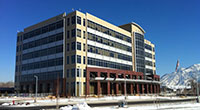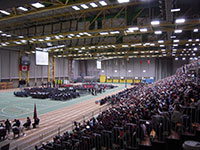view all Case Studies
Air Handler Helps Symphony Center Recover from Flood

Schermerhorn Symphony Center, completed in 2006, was becoming known as one of Nashville’s musical gems when the city’s worst-ever flood occurred in 2010.
September 19, 2011 -
HVAC
Schermerhorn Symphony Center, completed in 2006, was becoming known as one of Nashville’s musical gems when the city’s worst-ever flood occurred in 2010. The 197,000-square-foot, 1,844-seat neo-classical building suffered approximately $40 million in damages, including the loss of 11 air-handling units, which were custom-designed to provide efficient airflow at the lowest possible sound levels.
Everything was replaceable; the challenge was how to complete the job quickly and so that such damage would never happen again. Once the area was a clear zone, Nashville Symphony officials had four months to complete the task. A grand re-opening was scheduled for New Year’s Eve.
The original air-handling system utilized single large plenum fans and motors in custom cabinets. The six units serving the performance hall were stacked top-and-bottom units because of the extra space required by the plenum fans. With the location 20 to 30 feet below building grade, it would have been impossible to bring in motors or fan wheels to match the original units without knocking down one of the Symphony Center’s exterior walls.
The new air-handling units had to be compact enough to meet the space needs of a new flood-remediation scheme and quiet enough to measure up to the Symphony Center’s stringent noise criteria. The answer came in a modular knock-down air handler from Huntair, Inc. Integral to the air-handling units is Fanwall technology – an array of smaller fans and motors in individual cube-shaped cells, each of which houses a fan, motor and electrical connections.
To reach the original sound design levels, the original air-handling units had four-inch-thick panels with fiberglass insulation between two sheet-metal layers. Similar noise-attenuating panels are installed in the ductwork connected to the air handlers.
In most octave bands, the units were more than a 15 decibel improvement over the Symphony Center’s old air handlers. As a result, more than 25 percent of the sound-attenuation structure installed in the ductwork of the air-handling systems was removed. In addition, the six air handler systems serving the performance hall required much less sound-attenuating paneling than their much larger “stacked” predecessors.
The new units are single-level units sitting on structural steel platforms raised six feet off the floor of the mechanical rooms. The vertical space gained allow those spaces to be used as sump pits in the event of a future flood.
Next
Read next on FacilitiesNet












